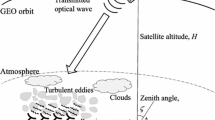Abstract
In this paper it is evaluated average channel capacity of an optical wireless communication system with aperture averaging and diversity reception over lognormal channels using a simple approximate closed form expression. The qualitative improvement in channel capacity is compared and investigated for various turbulence mitigation techniques: namely aperture averaging, diversity techniques such as maximal ratio combining and equal gain combining. Based on our study it is found that aperture averaging gives reasonably improved performance as compared to both types of diversity reception beyond certain turbulence strength. However, irrespective of turbulence strength, substantial improvement in capacity may be achieved with an array of direct detection receivers. Results obtained using the proposed expressions are in excellent agreement with those based on Monte Carlo simulations.
Similar content being viewed by others
References
Mohammad A. Khalighi, Murat Uysal, “Survey on free space optical communication: A communication theory perspective,” IEEE Commun. Surveys Tutorials 16, No. 4, 2231 (2014). DOI: 10.1109/COMST.2014.2329501.
Xiaoming Zhu, J. M. Kahn, “Free-space optical communication through atmospheric turbulence channels,” IEEE Trans. Commun. 50, No. 8, 1293 (Aug. 2002). DOI: 10.1109/TCOMM.2002.800829.
Larry C. Andrews, Ronald L. Phillips, Laser Beam Propagation through Random Media (SPIE Press, 1998), ISBN: 9780819459480.
Arun K. Majumdar, Advanced Free Space Optics (FSO): A Systems Approach (Springer-Verlag, New York, 2015). ISBN: 9781493909179, DOI: 10.1007/978-1-4939-0918-6.
James H. Churnside, “Aperture averaging of optical scintillations in the turbulent atmosphere,” Appl. Optics 30, No. 15, 1982 (1991). DOI: 10.1364/AO.30.001982.
Gerald E. Homstad, John W. Strohbehn, Roger H. Berger, J. M. Heneghan, “Aperture-averaging effects for weak scintillations,” JOSA A 64, No. 2, 162 (1974). DOI: 10.1364/JOSA.64.000162.
S. Mohammad Navidpour, Mural Uysal, Mohsen Kavehrad, “BER performance of free-space optical transmission with spatial diversity,” IEEE Trans. Wireless Commun. 6, No. 8, 2813 (Aug. 2007). DOI: 10.1109/TWC.2007.06109.
Jaime A. Anguita, Ivan B. Djordjevic, Mark A. Neifeld, Bane V. Vasic, “Shannon capacities and error-correction codes for optical atmospheric turbulent channels,” J. Optical Networking 4, No. 9, 586 (2005). DOI: 10.1364/JON.4.000586.
Hector E. Nistazakis, Evangelia A. Karagianni, Andreas D. Tsigopoulos, Michael E. Fafalios, George S. Tombras, “Average capacity of optical wireless communication systems over atmospheric turbulence channels,” J. Lightwave Technol. 27, No. 8, 974 (Apr. 2009). DOI: 10.1109/JLT.2008.2005039.
S. M. Haas, J. H. Shapiro, “Capacity of wireless optical communications,” IEEE J. Sel. Areas Commun. 21, No. 8, 1346 (Oct. 2003). DOI: 10.1109/JSAC.2003.816618.
Mohammad-Ali Khalighi, Noah Schwartz, Naziha Aitamer, Salah Bourennane, “Fading reduction by aperture averaging and spatial diversity in optical wireless systems,” J. Optical Commun. Networking 1, No. 6, 580 (2009). DOI: 10.1364/JOCN.1.000580.
E. J. Lee, V. W. S. Chan, “Part 1: Optical communication over the clear turbulent atmospheric channel using diversity,” J. Sel. Areas Commun. 22, No. 9, 1896 (Nov. 2004). DOI: 10.1109/JSAC.2004.835751.
M. M. Ibrahim, A. M. Ibrahim, “Performance analysis of optical receivers with space diversity reception,” IEE Proc. Commun. 143, No. 6, 369 (Dec. 1996). DOI: 10.1049/ip-com:19960885.
Mohamed Abaza, Raed Mesleh, Ali Mansour, El-Hadi M. Aggoune, “Diversity techniques for a free-space optical communication system in correlated log-normal channels,” Opt. Eng. 53, No. 1, 016102 (Jan. 2014). DOI: 10.1117/1.OE.53.1.016102.
W. O. Popoola, Z. Ghassemlooy, J. I. H. Allen, E. Leitgeb, S. Gao, “Free-space optical communication employing subcarrier modulation and spatial diversity in atmospheric turbulence channel,” IET Optoelectronics 2, No. 1, 16 (Feb. 2008). DOI: 10.1049/iet-opt:20070030.
Andrea Goldsmith, Wireless Communication (Cambridge University Press, 2005). ISBN: 9780521837163.
Emilio Rosenblueth, “Point estimates for probability moments,” Proc. NAS 72, No. 10, 3812 (1975). DOI: 10.1073/pnas.72.10.3812.
Karmeshu, Vineet Khandelwal, “On the applicability of average channel capacity in log-normal fading environment,” Wireless Personal Commun. 68, No. 4, 1393 (Feb. 2013). DOI: 10.1007/s11277-012-0529-2.
J. M. Holtzman, “A simple, accurate method to calculate spread-spectrum multiple-access error probabilities,” IEEE Trans. Commun. 40, No. 3, 461 (Mar. 1992). DOI: 10.1109/26.135712.
A. Laourine, A. Stephenne, S. Affes, “Estimating the ergodic capacity of log-normal channels,” IEEE Commun. Lett. 11, No. 7, 568 (Jul. 2007). DOI: 10.1109/LCOMM.2007.070302.
Optical Wireless Products, http://www.fsona.com/products.php.
Author information
Authors and Affiliations
Corresponding author
Additional information
Original Russian Text © R. Kaushik, V. Khandelwal, R.C. Jain, 2016, published in Izvestiya Vysshikh Uchebnykh Zavedenii, Radioelektronika, 2016, Vol. 59, No. 12, pp. 3–13.
About this article
Cite this article
Kaushik, R., Khandelwal, V. & Jain, R.C. Effect of aperture averaging and spatial diversity on capacity of optical wireless communication systems over lognormal channels. Radioelectron.Commun.Syst. 59, 527–535 (2016). https://doi.org/10.3103/S0735272716120013
Revised:
Published:
Issue Date:
DOI: https://doi.org/10.3103/S0735272716120013




